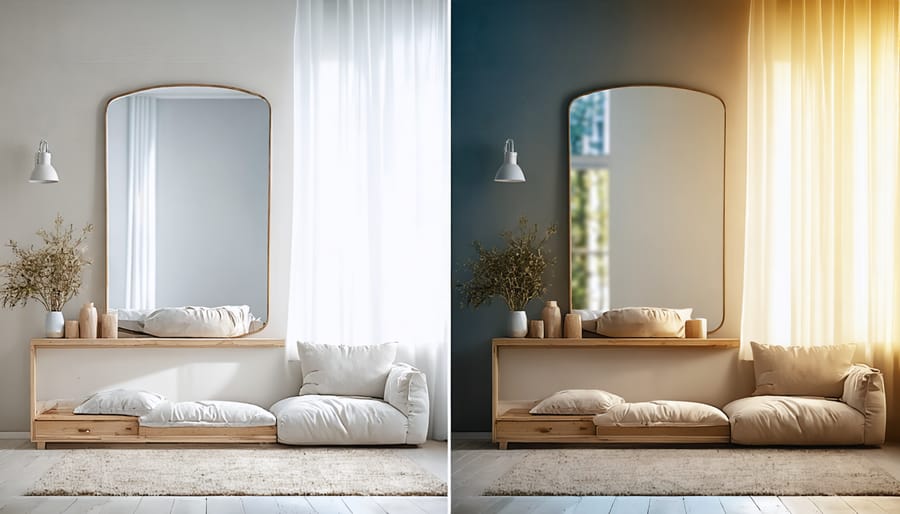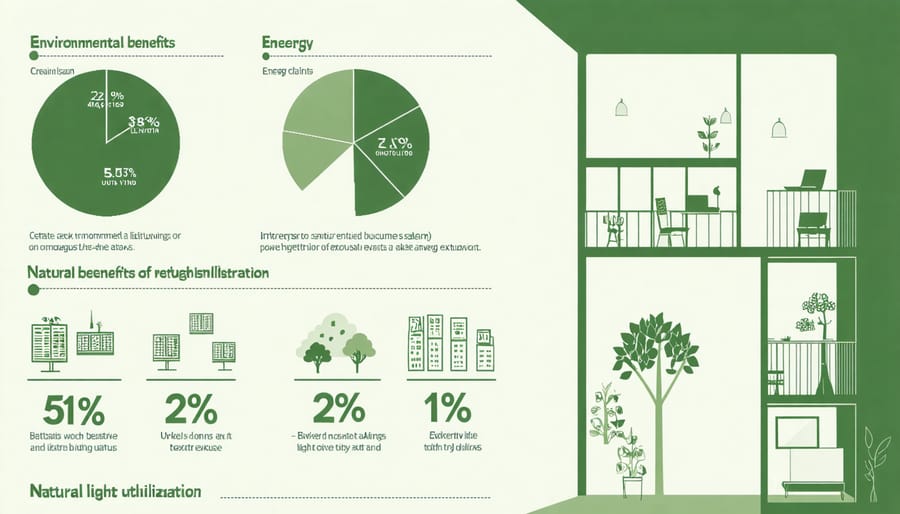Natural sunlight does more than just brighten our homes – it fundamentally shapes our well-being, productivity, and quality of life. Research shows that exposure to natural light boosts vitamin D production, regulates our circadian rhythm, and can reduce energy bills by up to 35%. From improved mood and better sleep to enhanced cognitive performance, the benefits of natural light extend far beyond simple illumination.
In today’s world, where we spend over 90% of our time indoors, maximizing natural light exposure has become crucial for both physical and mental health. Studies from the World Health Organization indicate that adequate natural light exposure can decrease depression symptoms by 40%, improve workplace productivity by 15%, and significantly reduce eye strain compared to artificial lighting.
Whether you’re redesigning your home office, planning a renovation, or simply seeking ways to enhance your living space, understanding and harnessing natural light’s benefits can transform your indoor environment. The good news? Incorporating more natural light into your daily routine doesn’t always require major renovations – sometimes, simple adjustments can make a significant difference in how much beneficial daylight reaches your indoor spaces.
This guide explores the science-backed advantages of natural light and provides practical solutions to maximize its presence in your home and life.
The Science Behind Natural Light’s Impact on Well-being
Circadian Rhythm Regulation
Natural light plays a crucial role in regulating your body’s internal clock, also known as your circadian rhythm. When sunlight enters your eyes, it signals to your brain that it’s time to be alert and active, triggering the production of serotonin – a hormone that helps boost mood and energy levels. As darkness falls, your body naturally begins producing melatonin, the sleep hormone that helps you wind down and prepare for rest.
Getting enough natural light during the day, especially in the morning, helps maintain this delicate balance. Try to spend at least 30 minutes near a window or outdoors during the early hours of your day. This exposure helps set your internal clock, making it easier to fall asleep at night and wake up feeling refreshed in the morning.
For those working from home or in offices, positioning your desk near a window can make a significant difference in maintaining healthy sleep patterns. If you’re renovating or redecorating, consider ways to maximize natural light in spaces where you spend most of your daylight hours. Even small changes, like keeping windows clean and moving furniture that blocks light, can help support your body’s natural rhythm.
Mental Health Benefits
Natural light plays a crucial role in maintaining and improving our mental well-being, with numerous studies backing its positive effects on our psychological health. Exposure to natural daylight helps regulate our circadian rhythm, which directly impacts our mood, stress levels, and overall mental clarity.
Research shows that people who receive adequate natural light during the day experience reduced symptoms of depression and anxiety. In fact, studies have found that workers in offices with abundant natural light report 56% fewer headaches and experience less eye strain and drowsiness compared to those in artificially lit environments.
The morning sunlight is particularly beneficial, triggering the release of serotonin – often called the “happy hormone” – which helps boost mood and focus. This natural process is far more effective than artificial alternatives, though you can complement it with mood-boosting lighting solutions when natural light isn’t available.
For those working from home, positioning your desk near a window or spending your breaks in naturally lit areas can significantly improve your mental well-being. Even brief exposure to natural light during the day can help reduce seasonal affective disorder (SAD) symptoms and promote a more positive outlook.

Smart Ways to Maximize Natural Light in Your Home
Window Optimization
Maximizing natural light starts with smart window optimization. Following biophilic design principles, there are several effective strategies to enhance light entry through your windows.
First, ensure your windows are clean inside and out – dust and dirt can significantly reduce light transmission. Trim any outdoor vegetation that might be blocking sunlight, keeping branches at least three feet away from windows.
For window treatments, opt for light, sheer fabrics that filter rather than block light. Consider installing top-down, bottom-up shades that allow you to control light entry while maintaining privacy. When selecting curtains, mount them higher and wider than the window frame – this allows you to pull them completely clear of the glass when open.
Strategic mirror placement can amplify natural light by reflecting it deeper into your space. Position mirrors on walls adjacent or opposite to windows for maximum effect. Consider installing glass doors or transom windows above regular doors to allow light flow between rooms.
For those planning renovations, consider enlarging existing windows or adding new ones on south-facing walls (north-facing for Southern Hemisphere). Skylights and solar tubes are excellent options for rooms where traditional windows aren’t feasible.
Remember to balance light entry with thermal efficiency. Using double-pane windows or applying UV-filtering window films can help maintain comfortable indoor temperatures while maximizing natural light benefits.
Strategic Mirror Placement
Strategic mirror placement is one of the most effective and budget-friendly ways to maximize natural light in your home. Mirrors work like magic, reflecting and bouncing daylight into darker corners and creating the illusion of brighter, more spacious rooms.
To get the most from this technique, position large mirrors directly opposite windows to capture and reflect incoming light. This essentially creates a second light source in your room. For optimal results, choose mirrors that are at least half the size of your window to ensure substantial light reflection.
Consider placing mirrors adjacent to windows at a slight angle to direct light into specific areas of your room. This works particularly well in narrow hallways or rooms with limited window access. For dining areas, a strategically placed mirror can create a lovely ambiance while brightening the space.
Don’t limit yourself to wall mirrors – mirrored furniture pieces and decorative elements can also contribute to your lighting strategy. Try incorporating mirrored trays on coffee tables or mirrored cabinet fronts in darker corners.
Pro tip: When positioning mirrors, take a moment to observe what they’ll reflect. Aim to capture pleasant views and avoid reflecting cluttered areas or direct sunlight that might create glare. Also, keep your mirrors clean and dust-free to maintain maximum reflective properties.
Remember that different rooms may require different approaches. Experiment with various positions and angles until you find the perfect setup for each space.

Color and Material Choices
Maximizing natural light starts with smart color and material selections that can transform your space into a true wellness sanctuary. Light colors are your best friends when it comes to brightening up your space. Opt for whites, creams, and pale pastels for walls and ceilings, as these shades reflect up to 80% of the light that hits them, compared to dark colors that may only reflect 10-20%.
Consider using semi-gloss or eggshell finishes instead of flat paints, as they create a subtle reflective surface that helps bounce light around the room. For flooring, light-colored hardwood or tiles can significantly brighten your space, while glossy tiles or polished wooden surfaces add an extra reflective boost.
Mirrors and metallic accents are game-changers for enhancing natural light. Strategic mirror placement opposite windows doubles the incoming light while creating the illusion of more space. Chrome, brass, or copper fixtures and decorative elements add sparkle and help distribute light throughout the room.
Don’t forget about window treatments – opt for lightweight, sheer fabrics that filter light without blocking it completely. Light-colored blinds or curtains in natural materials like linen or cotton allow you to control light levels while maintaining the bright, airy feel you’re after.
Overcoming Common Natural Light Challenges
North-Facing Rooms
North-facing rooms often get a bad rap for being darker and less inviting, but with the right strategies, you can maximize the available natural light and create a bright, welcoming space. Start by choosing light-reflecting colors for your walls and ceiling – soft whites, pale grays, and gentle creams work wonders in bouncing what little light you have around the room.
Strategic mirror placement can be your secret weapon. Position a large mirror opposite your window to double the light’s impact, or create a gallery wall of smaller mirrors to scatter light throughout the space. Consider using mirrors with beveled edges for added sparkle and interest.
Trim back any outdoor vegetation that might be blocking your windows, and keep your windows spotlessly clean – you’d be surprised how much difference this makes. Choose window treatments that don’t obstruct light when open; opt for lightweight, sheer curtains or top-down bottom-up blinds that allow light in while maintaining privacy.
Furniture arrangement matters too. Keep taller pieces away from windows and opt for furniture with lighter finishes or glass elements. Consider using glossy surfaces sparingly throughout the room – a glass coffee table or high-shine picture frames can help reflect light without overwhelming the space.
Finally, supplement natural light with layered artificial lighting. Use a mix of ceiling, wall, and table lamps to create a bright atmosphere that mimics natural light when the sun isn’t cooperating.
Small Windows
Don’t let small windows limit your access to natural light! With a few clever strategies, you can maximize the brightness these modest openings provide. Start by keeping your windows spotlessly clean and removing any outdoor obstacles like overgrown bushes that might block light. Consider installing mirrors on the wall opposite your windows to reflect and amplify incoming light throughout the room.
Light-colored window treatments can make a significant difference. Opt for sheer curtains or top-down, bottom-up blinds that allow you to control light while maintaining privacy. When choosing paint colors, stick to light, reflective shades for walls and ceilings – they can make your space feel significantly brighter.
Strategic furniture placement is crucial. Avoid blocking windows with large pieces, and consider using glass or lucite furniture that won’t obstruct light flow. Adding metallic accents and glossy surfaces around your windows can help bounce light deeper into your space.
For a more significant upgrade, consider installing window films that redirect light upward toward the ceiling, helping it spread throughout the room. Glass blocks or transom windows above doors can also introduce additional natural light without compromising privacy.
Remember, even small changes can make a big difference. Try placing a bright, light-colored rug near your window to reflect more light upward, or position plants strategically to create interesting light patterns without blocking the main light source.

Energy and Cost Benefits
Natural light isn’t just beautiful – it’s also a powerful ally in reducing your energy costs and environmental footprint. By maximizing daylight in your home, you can significantly decrease your reliance on artificial lighting during daytime hours, leading to noticeable savings on your electricity bills.
Studies show that homes optimized for natural light can reduce artificial lighting needs by up to 80% during daylight hours. This reduction directly translates to lower energy consumption and smaller utility bills. In fact, the average household can save between $100-200 annually just by making better use of available daylight.
But the energy benefits don’t stop at lighting. Natural light also plays a crucial role in passive solar heating, which can help warm your home during colder months. When strategically planned, windows and skylights can harness the sun’s warmth, reducing heating costs during winter. Similarly, proper window placement and treatments can help minimize heat gain during summer, lowering cooling costs.
The environmental impact is equally impressive. By reducing your dependence on artificial lighting and heating/cooling systems, you’re automatically lowering your carbon footprint. This contribution to environmental sustainability adds another layer to creating a healthier living environment for both your family and the planet.
Consider these practical tips to maximize energy savings:
– Install light-colored window treatments that can be easily adjusted
– Keep windows clean to optimize light transmission
– Position furniture to avoid blocking natural light sources
– Use mirrors strategically to reflect and amplify available daylight
– Consider installing solar tubes or skylights in darker areas
Remember, even small changes in how you utilize natural light can lead to meaningful reductions in energy consumption and costs over time. The initial investment in optimizing your home for natural light often pays for itself through years of energy savings and increased property value.
The profound impact of natural light on our well-being, productivity, and living spaces cannot be overstated. As we’ve explored throughout this article, incorporating more daylight into your home brings numerous benefits, from improved mood and better sleep patterns to increased energy efficiency and enhanced interior aesthetics.
By implementing some of the strategies we’ve discussed, such as strategically placing mirrors, choosing light-colored décor, and keeping windows clean and unobstructed, you can dramatically transform your living space. Remember that even small changes can make a significant difference – start with one room and gradually work your way through your home.
Consider your daily routines and how you can maximize exposure to natural light during peak hours. Whether it’s repositioning your workspace near a window or creating a cozy reading nook in a sun-filled corner, these thoughtful adjustments can significantly impact your daily well-being.
Don’t let obstacles like rental restrictions or budget constraints discourage you. There are solutions for every situation, from affordable window treatments to portable mirrors and strategic furniture arrangement. The key is to start somewhere and build upon your success.
Take action today to bring more natural light into your living spaces. Your body, mind, and energy bills will thank you. The benefits of natural light are too valuable to ignore, and the improvements you make now will continue to enhance your quality of life for years to come.
